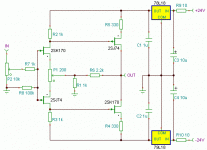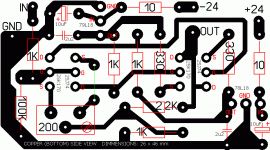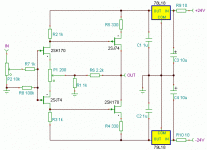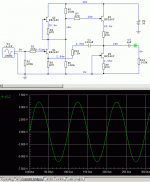The one I attached will do nicely - it sounds very good and it's easy to build. F5 is very light load (100k).
R6/R1 ratio sets the gain (make them both 1k for the gain of 2V/V or 6 dB) and P1 sets the DC offset on output.
You can use F5's PS to make a regulated PS for this preamp.
Input pair of K170/J74 can be GR or BL ; output ones are BL or V.
R6/R1 ratio sets the gain (make them both 1k for the gain of 2V/V or 6 dB) and P1 sets the DC offset on output.
You can use F5's PS to make a regulated PS for this preamp.
Input pair of K170/J74 can be GR or BL ; output ones are BL or V.
Attachments
Anything wrong with B1?Any good DIY options out there that are on the easy side to build?
F5 has a gain of 6, B1 has less than 1, and the one published above 2, making a total gain of 6 & 12 respectively.
Assuming you have no low level source like tape or phono, and only single ended CD at about +/-2V output max. That means a maximum output of +/-12V and +/-24V respectively. Not much left for volume control ??
Of course it would be just perfect if you have a digital attenuator in your source. Then maybe you don't even have to bother with the B1 and just connect the source straight to the F5.

Patrick
Assuming you have no low level source like tape or phono, and only single ended CD at about +/-2V output max. That means a maximum output of +/-12V and +/-24V respectively. Not much left for volume control ??
Of course it would be just perfect if you have a digital attenuator in your source. Then maybe you don't even have to bother with the B1 and just connect the source straight to the F5.
Patrick
Not at allHBarske said:Anything wrong with B1?
EUVL said:
Assuming you have only single ended CD at about +/-2V output max. That means a maximum output of +/-12V and +/-24V respectively. Not much left for volume control ??
Patrick
Enjoying CD-B1-F5 and Jordan JX92S which are 88db SPL 1m 1w , very ok with volume control .
Ahhhh the B1 is very very good
stefanobilliani said:Ahhhh the B1 is very very good

Very good.. but why good? Thanks..
HBarske said:Anything wrong with B1?
Nothing at all... Except that it's not a preamp - it's a unity gain buffer stage - the thread is about preamp.
My source can't drive F5 to full power without additional gain (6 dB at least).

Babowana said:
Very good.. but why good? Thanks..
Becouse of its sound and its volume control tracking . There is no changing in sound caracter turning the pot , the buffer is no feedback ... . IMHO much better than just a pot also when you are ok with impedance matching .
And of course it is a preamp . since it amplyfies the current of the signal .
stefanobilliani said:
...
And of course it is a preamp . since it amplyfies the current of the signal .
No, it's not a preamp. Amplifiers are gain devices, determined by voltage amplification. Current amplification is something else - it's called impedance matching.
This can be argued but it's consensual definition.
BTW, F5 doesn't need impedance matching. Its' input impedance is the similar as B1's.
juma said:
This can be argued but it's consensual definition.
Nice to meet you, Mr. Consensual.
juma said:
Amplifiers are gain devices
Infact the B1 is a gain device .
F5 needs a volume control
juma said:The one I attached will do nicely - it sounds very good and it's easy to build. F5 is very light load (100k).
R6/R1 ratio sets the gain (make them both 1k for the gain of 2V/V or 6 dB) and P1 sets the DC offset on output.
You can use F5's PS to make a regulated PS for this preamp.
Input pair of K170/J74 can be GR or BL ; output ones are BL or V.
Very good juma
I couldnt have made it better myself
.... I wish i had .. before you did juma
Attachments
If one needs no additional gain, I personally would just put an attenuator (or passive preamp, or whatever else you want to call it) right at the input of the F5, driven directly from the CD player. With 101k input resistance, there is no real need of a buffer stage if you use a 10k attneuator (which an avergae CD player will drive easily) and no long cables in between).
BUT personally taste. Everyone is entitled to choose his own favoured solution.
Patrick
BUT personally taste. Everyone is entitled to choose his own favoured solution.
Patrick
this may be the first option to try, EUVL
now i would use a volume pot of 22k/25k instead
as my CD-output is limited to minimum ~15 kOhm
good advice by EUVL:
- do not add things to your sound system signal chain '
.. that you do not really need

.. any addition will more or less make you signal worse
this is the hard facts!
now i would use a volume pot of 22k/25k instead
as my CD-output is limited to minimum ~15 kOhm
good advice by EUVL:
- do not add things to your sound system signal chain '
.. that you do not really need
.. any addition will more or less make you signal worse
this is the hard facts!
lineup said:
Very good juma
I couldnt have made it better myself
.... I wish i had .. before you did juma
Sorry lineup, but I can not be credited for that circuit. I found it in one of the articles published on E. Borbely's site and it seemed to me a right preamp for F5. Most important drawback of this preamp is its inability to drive very low impedances, but it won't be the problem with F5 (101 k Zin). It produces 5V output (peak) with ease and it sounds lovely (no change in F5's sound character, only higher output) - that's all I need
Sound lovely!
I guess so
JFET output. JFET input is excellent. Many opamp use it.
Output, as you say can be a bit much distortion, if too much loaded.
But 100 kohm is perfect for JFET output.
Nelson Pass has been kind to us.
Setting input impedance high as 100 kohm in F5.
Means Tube or This JFET amplifier can be used for F5.
Of course JFET Op-Amps like OPA2134 would be another option.
Again .. very nice little amplifier. Thanks for publish here, juma.
Even if some other made this amp.
Lineup
I guess so
JFET output. JFET input is excellent. Many opamp use it.
Output, as you say can be a bit much distortion, if too much loaded.
But 100 kohm is perfect for JFET output.
Nelson Pass has been kind to us.
Setting input impedance high as 100 kohm in F5.
Means Tube or This JFET amplifier can be used for F5.
Of course JFET Op-Amps like OPA2134 would be another option.
Again .. very nice little amplifier. Thanks for publish here, juma.
Even if some other made this amp.
Lineup
Here is another idea that I've been playing with. It's based on J. Broskie's Aikido tube design. I used FETs that are cheap and abundant. Recorded values from simulation software are pretty much consistent with real life circuit (it's often true for simple circuits).
By listening to it I cannot find a fault, but it has certain drawbacks from designer's point of view:
- higher PS voltage (must be derived from separate transformer or by means of voltage doubler from F5's transformer)
- PS voltage must be very clean
- design uses a couple of coupling caps
OTOH, it's simple, easy to build, no hard to find parts, highly customizable (use of other FETs possible), no P-channel FETs needed, and IMHO, it sounds good
By listening to it I cannot find a fault, but it has certain drawbacks from designer's point of view:
- higher PS voltage (must be derived from separate transformer or by means of voltage doubler from F5's transformer)
- PS voltage must be very clean
- design uses a couple of coupling caps
OTOH, it's simple, easy to build, no hard to find parts, highly customizable (use of other FETs possible), no P-channel FETs needed, and IMHO, it sounds good
Attachments
juma said:Here is another idea that I've been playing with. It's based on J. Broskie's Aikido tube design. I used FETs that are cheap and abundant. Recorded values from simulation software are pretty much consistent with real life circuit (it's often true for simple circuits).
By listening to it I cannot find a fault, but it has certain drawbacks from designer's point of view:
- higher PS voltage (must be derived from separate transformer or by means of voltage doubler from F5's transformer)
- PS voltage must be very clean
- design uses a couple of coupling caps
OTOH, it's simple, easy to build, no hard to find parts, highly customizable (use of other FETs possible), no P-channel FETs needed, and IMHO, it sounds good
use fb arrangement as in inverted OP amp , then you'll loose one cap ;
- Status
- This old topic is closed. If you want to reopen this topic, contact a moderator using the "Report Post" button.
- Home
- Amplifiers
- Pass Labs
- Preamp ideas for F5



